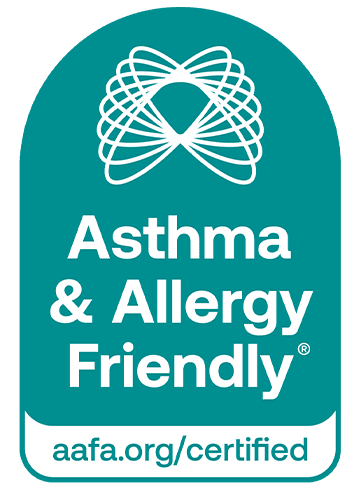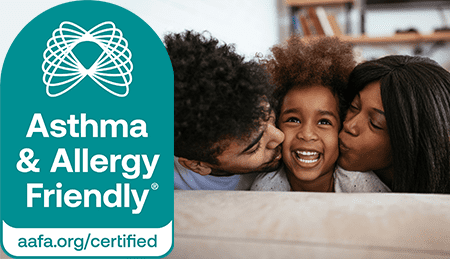Allergies
Dust Mite Allergy
Dust mites may be the most common trigger of year-round allergies and allergic asthma. They are on every continent except Antarctica. It may not be possible to rid your home entirely of these creatures. But there are ways in which you can lessen your allergic reactions to them.
What Is a Dust Mite?
A dust mite measures only about one-quarter to one-third of a millimeter. They are too small to see with your eyes alone. Under a microscope, they look like white bugs. They have eight legs, so they are not insects, but arthropods, like spiders.
Dust mites thrive in temperatures of 68 to 77 F (20 to 25 C). They also like humidity levels of 70 to 80%. There are at least 13 species of mites. They are all well adapted to the environment inside your home. They feed mainly on the tiny flakes of human skin that people shed each day. These flakes work their way deep into the inner layers of furniture, carpets, bedding and even stuffed toys. These are the places where mites thrive. An average adult person may shed up to 1.5 grams of skin in a day. This is enough to feed one million dust mites!
What Is a Dust Mite Allergy?
An allergen is a substance that causes an allergic reaction. Both the body parts and the waste of dust mites are allergens for many people. Most dust mites die in low humidity levels or extreme temperatures. But they leave their dead bodies and waste behind. These can continue to cause allergic reactions. In a warm, humid house, dust mites can survive all year.
What Are the Symptoms of Dust Mite Allergy?
Common dust mite allergy symptoms include:
- Sneezing
- Runny nose
- Itchy, red, or watery eyes
- Stuffy nose
- Itchy nose, mouth, or throat
- Itchy skin
- Postnasal drip (a flow of mucus from behind your nose into your throat)
- Cough
If your dust mite allergy triggers your asthma, you may also experience:
- Difficulty breathing
- Chest tightness or pain
- A whistling or wheezing sound when breathing out
- Trouble sleeping caused by shortness of breath, coughing, or wheezing
How Does a Doctor Diagnose Dust Mite Allergy?
To diagnose a dust mite allergy, your doctor may give you a physical exam and discuss your symptoms. If your doctor thinks you have a dust mite allergy, they may suggest a skin or blood test. If you have symptoms year-round, you could have a dust mite allergy.
Skin Prick Test (SPT)
In prick/scratch testing, a small drop of the possible allergen is placed on your skin. Then the nurse or doctor will lightly prick or scratch the spot with a needle through the drop. If you are allergic to the substance, you will develop redness, swelling and itching at the test site within 20 minutes. You may also see a wheal. A wheal is a raised, round area that looks like a hive. Usually, the larger the wheal, the more likely you are to be allergic to the allergen.
A positive SPT to a particular allergen does not necessarily mean you have an allergy. Health care providers must compare the skin test results with the time and place of your symptoms to see if they match.
Specific IgE Blood Test
Blood tests are helpful when people have a skin condition or are taking medicines that interfere with skin testing. They may also be used in children who may not tolerate skin testing. Your doctor will take a blood sample and send it to a laboratory. The lab adds the allergen to your blood sample. Then they measure the amount of antibodies your blood produces to attack the allergens. This test is called Specific IgE (sIgE) Blood Testing. (This was previously and commonly referred to as RAST or ImmunoCAP testing.) As with skin testing, a positive blood test to an allergen does not necessarily mean that an allergen caused your symptoms.
What Is the Treatment for Dust Mite Allergy?
The most important step is to avoid dust mites as much as possible. Limiting your exposure to dust mites will reduce your symptoms. However, it’s nearly impossible to completely get rid of dust mites in your environment. You may also need medicines to control symptoms.
Certain over-the-counter and prescription medicines may help reduce dust mite allergy symptoms.
- Antihistamines are available as pills, liquids, or nose sprays. They can relieve sneezing and itching in the nose and eyes. They also reduce a runny nose and, to a lesser extent, nasal stuffiness.
- Nasal corticosteroids are a type of nose spray. They reduce swelling in your nose and block allergic reactions. They are the most effective medicine type for allergic rhinitis because they can reduce all symptoms, including nasal congestion. Nasal corticosteroids have few side effects.
- Leukotriene receptor antagonists block the action of important chemical messengers (other than histamine) involved in allergic reactions.
- Cromolyn sodium is a nose spray that blocks the release of chemicals that cause allergy symptoms, including histamine and leukotrienes. This medicine has few side effects, but you must take it four times a day.
- Decongestants are available as pills, liquids, nose sprays or drops. They help shrink the lining of the nasal passages and relieve stuffiness. Use decongestant nose drops and sprays only for a short time. Oral decongestants can cause side effects such as sleeplessness and increased blood pressure in some people. Consider checking with your doctor before using them.
Many people with a dust mite allergy do not get complete relief from medicines. This means they may consider immunotherapy (allergy shots). Immunotherapy is a long-term treatment that can help prevent or reduce the severity of allergic reactions. It can reduce the course of allergic disease by changing your body’s immune response to allergens.
Allergy Shots – subcutaneous immunotherapy (SCIT) is an effective treatment that has been around for more than 100 years. SCIT is a series of shots that have progressively larger amounts of allergen. An injection of the allergen goes into the fat under your skin about once a week during the initial phase of treatment. Many patients get complete relief of their allergies after being on SCIP for one to three years. Many physicians will continue SCIT for a period of five or more years. SCIT can provide long-lasting symptom relief. Many people experience benefits for at least several years after the shots stop.
Sublingual (under-the-tongue) immunotherapy (SLIT) is a way to treat dust mite allergies without injections. Patients put small doses of an allergen under the tongue. This exposure improves tolerance to the dust mites and reduces symptoms. SLIT tablets that treat dust mite allergy were approved by the FDA in 2017. Talk with your allergist if you want to learn more about SLIT.
How Can I Prevent Allergic Reactions to Dust Mites?
Remember, having dust mites doesn’t mean your house isn’t clean. In most areas of the world, these creatures live in every home, no matter how clean. But, you can reduce their effects. There are many changes you can make to your home to reduce the numbers of these unwanted “guests.”
Studies show that more dust mites live in your bedroom than anywhere else in your home. So this is the best place to start.
- Cover mattresses and pillows in zippered dust-proof covers. These covers are made of a material with pores too small to let dust mites and their waste product through. They are also called allergen-impermeable. Plastic or vinyl covers are the least expensive, but some people find them uncomfortable. You can buy other fabric allergen-impermeable covers from many regular bedding stores.
- Wash your sheets and blankets weekly in hot water. You have to wash them in water that’s at least 130 F or more to kill dust mites.
- Get rid of all types of fabric that mites love and that you cannot easily wash regularly in hot water. Avoid wall-to-wall carpeting, curtains, blinds, upholstered furniture and down-filled covers and pillows in the bedroom. Put roll-type shades on your windows instead of curtains.
- Have someone without a dust mite allergy clean your bedroom. If this is not possible, wear a filtering mask when dusting or vacuuming. Many drug stores carry these items. Dusting and vacuuming stir up dust. So try to do these chores when you can stay out of the bedroom for a while afterward.
- Certified Asthma & Allergy Friendly® vacuum cleaners can help to keep mites and mite waste from getting back into the air. Certified vacuums are scientifically tested and verified as more suitable for making your home healthier.
- Vacuuming is not enough to remove all dust mites and their waste. A large amount of the dust mite population may remain because they live deep inside the stuffing of sofas, chairs, mattresses, pillows, and carpeting.
Treat other rooms in your house like your bedroom. Here are more tips:
- Avoid wall-to-wall carpeting, if possible. If you do use carpeting, mites don’t like the type with a short, tight pile as much. Use washable throw rugs over regularly damp-mopped wood, linoleum or tiled floors.
- Wash rugs in hot water whenever possible. Cold water isn’t as effective. Dry cleaning kills all dust mites and is also good for removing dust mites from living in fabrics.
- Keep the humidity in your home less than 50%. Use a dehumidifier and/or air conditioner to do this.
- Use a Certified Asthma & Allergy Friendly® filter with your central furnace and air conditioning unit. This can help trap dust mites from your entire home. Freestanding air cleaners only filter air in a limited area. Avoid devices that treat air with heat, electrostatic ions, or ozone.
Using CERTIFIED asthma & allergy friendly® products in your home can help you have a healthier indoor environment, as well as reduce allergens.
Learn more about the asthma & allergy friendly® Certification Program by visiting aafa.org/certified.
Medical Review October 2015.
.
Using Certified Asthma & Allergy Friendly® products in your home can help you have a healthier indoor environment, as well as reduce allergens.
To learn more about the Asthma & Allergy Friendly® Certification Program, visit: aafa.org/certified












